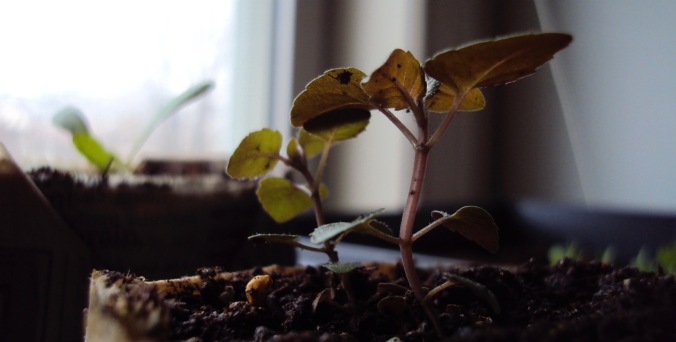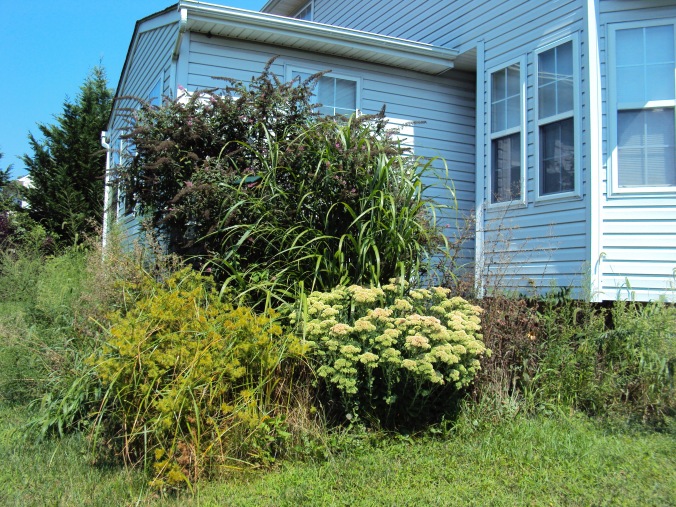
All of this started with craving a sense of place.
Okay to be fair, it also sort of started with my dad digging out six to eight inches of clayish dirt and builder’s gravel in the corner of our house and laboriously filling the resultant hole with hand-mixed topsoil, sand, and peat.
So maybe we should begin there.
history of a twenty-something gardener:
My family’s been in this house since it was built in the early 2000s, and I’ve (theoretically) been gardening for most of that time (with the aforementioned landscaping assistance, thanks Dad, A+ work).
For more than a decade my plot sort of stuttered along as a haphazard assortment of pretty things, because rhyme or reason is for people not on a teenager’s allowance who can afford to buy more than one or two perennials in a year. From nurseries and sales I collected – with varying levels of success – bleeding heart, hens and chicks, zinnia, marigold, showy evening primrose, ‘Elijah’ blue fescue, gladiolus, pincushion flower, purple coneflower, and iris. From my parents’ planting leftovers I got catmint, half a dozen crocus bulbs, and groundcover sedums. From a friend of the family I got free dill, lance-leaf coreopsis, variegated vinca, more sedum, Siberian iris, and a tiny butterfly bush. And from the local seed bank I got weeds, lots of. Generally to a height of five or six feet.

This is, of course, generally what happens when you fill a hole with fertile delicious dirt, only put about ten plants in it, and get unhelpfully philosophical at the prospect of weeding because who are you really to decree that this arbitrary plant deserves to live and this other arbitrary plant deserves to die for the convenience of your Aesthetic?
This is pretty much how it went until 2014, when I graduated from college, got my first job, and realized I finally had the luxury of cultivating a moderately expensive hobby should I so desire.
a sense of place:
I went to school six hours from home, so by the time I graduated, part of me was getting really sick of feeling like I didn’t really live anywhere in particular, of having to pack up and move from dorms to home and back every couple of months. It’d be nice to settle down in one place again for a couple years while I decided where I was going next.
Except I didn’t feel like I’d ever managed to grow roots at home, either. I grew up in this place, yeah, but mostly I just existed in it. My town’s too small to have a lot of amenities; it’s a place you move to so you can raise your kids in big yards and small schools and spend the rest of your time driving to other places for the things you want and need. What exactly was so particular about living here rather than any other place? There’s a hundred towns like it, aren’t there? The same houses and suburbs, the same landscaping aesthetics, the same robins and grackles and finches, the same rippling fields of crops and tangled patches of woods, the same acres and acres of green lawn.
It didn’t really help that I never had any particular understanding of what I was looking at, botanically. A walk in the woods registered as “trees and green stuff” (or if I was lucky, “ooh look a fern“). Roadside margins were either “mowed grass and stuff,” “a thicket and stuff,” or “weeds and stuff.” Every woods looked like the same woods and every meadow looked like weeds.
When I started learning to identify local plants and especially natives, learning about the botanical variance across Maryland alone, learning about plant communities and ecosystems and succession, getting familiar with the species that grow here and how well they play together in gardens or in the wild, discovering the native species that have survived on our property the whole time – suddenly I found myself very interested in the particulars of this place.
It’s hard to describe the thrill that comes from finding a native plant growing wild for the first time. The closest thing I’ve been able to come up with is that it’s like, imagine all of your friends are friends with this other person, and you’re always hearing hilarious stories about them, and you’ve maybe Facebook stalked them once or twice but you’ve never actually met, and then one day you finally run into them in a crowd of strangers and get inappropriately excited about it, so that all you can think to do is keep pointing enthusiastically at them like “YOU. HI. I KNOW YOU. YOU ARE THE PERSON.”
So I pay attention now, while I’m driving to get the things I want and need. I’m watching the wild redbuds and dogwoods bloom along the highways in spring, and the colonies of common milkweed emerge from the median strips. When I drive through woods I watch for patches of mayapple in the spring and jewelweed in the fall and the pale trunks of sycamore in winter. I notice all the different colors in a field of unmowed grass because I’m thinking about how many different species have apparently crammed themselves into that space.
And all of these things together mean that this part of the country no longer just registers as “trees and weeds and other green stuff.” It feels like home.